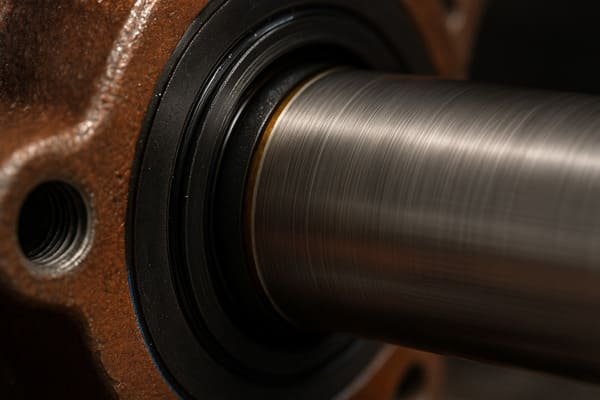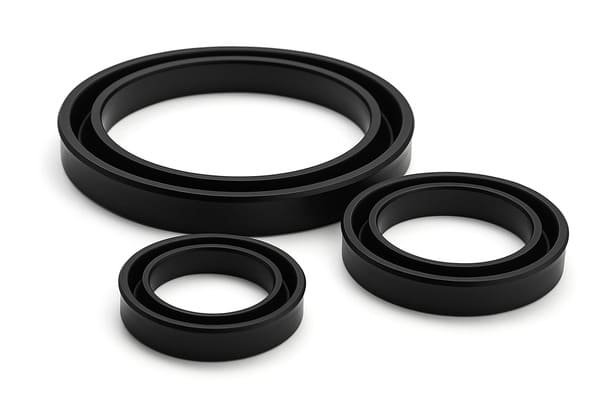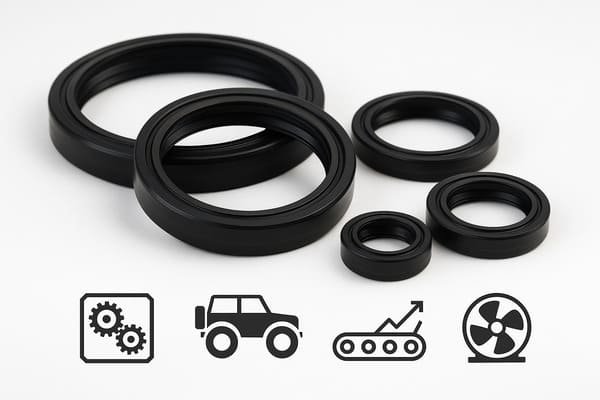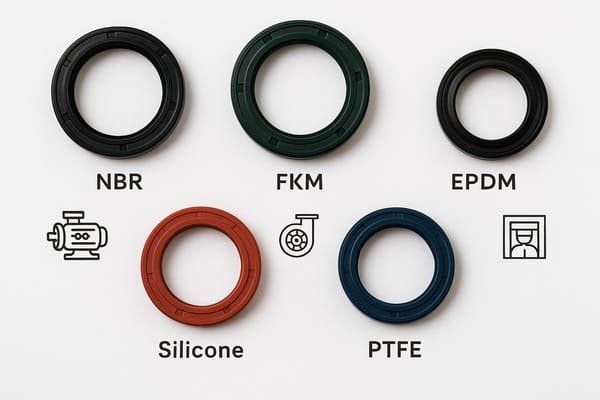When parts move, leaks follow—unless you have the right seal in place. That’s where dynamic seals come in. They work where static seals fail.
A dynamic seal is a sealing element designed to prevent fluid or gas leakage between parts that move relative to each other, such as rotating shafts or reciprocating pistons.

In my experience, many system failures start with the wrong assumption: that one type of seal works for everything. But when your equipment has motion, only a dynamic seal can handle the job.
What makes a seal dynamic?
Dynamic seals aren’t just pressed into place—they actively perform under movement, heat, and friction.
A dynamic seal maintains contact with a moving surface, adapting to changes in position while keeping out contaminants and retaining fluids.

🛠️ Key Characteristics of Dynamic Seals
| Feature | Description |
|---|---|
| Motion | Seals parts with relative movement |
| Seal design | Usually includes a flexible lip |
| Typical movement types | Rotary (shafts), reciprocating (pistons) |
| Common materials | NBR, FKM, PTFE, polyurethane |
| Examples | Oil seals, hydraulic rod seals, shaft seals |
We supply a lot of FKM shaft seals1 for motor assemblies. These seals have to endure thousands of revolutions per minute, retain oil, and survive exposure to high heat and mechanical stress.
Where are dynamic seals used?
You’ll find dynamic seals wherever motion meets pressure. Pumps, engines, gearboxes—every rotating or sliding part needs one.
Dynamic seals are used in systems where parts move, including hydraulic cylinders, rotating shafts, compressors, mixers, and motors.
📍 Common Applications
| Industry | Dynamic Seal Use Case |
|---|---|
| Automotive | Crankshaft seals, valve stem seals |
| Hydraulic | Rod and piston seals |
| HVAC motors | Fan shaft seals |
| Pumps | Impeller shaft sealing |
| Food machinery | Rotary joint seals with FDA elastomers2 |
We often provide PTFE-blend dynamic seals3 for food mixers, where high-speed rotation4 and hygiene both matter. In these cases, the material must resist both wear and chemicals.
What types of dynamic seals are there?
Dynamic seals come in various shapes depending on movement type and installation method.
Common types of dynamic seals include lip seals, rotary shaft seals, piston seals, and mechanical face seals.

🔍 Dynamic Seal Types
| Type | Movement Type | Best For |
|---|---|---|
| Lip seal (radial) | Rotary | Motor shafts, gearboxes |
| Piston seal5 | Reciprocating | Hydraulic cylinders |
| Rod seal | Reciprocating | Preventing leaks on retracting stroke |
| Mechanical face seal6 | Rotary | High-pressure pumps |
| Rotary union seal7 | Rotary | Fluid transfer during rotation |
Each of these requires a different groove design and compression range. You can’t swap a piston seal for a shaft seal and expect it to work.
What is an example of a dynamic seal?
Rotating shafts, sliding rods—these parts need seals that move with them. Let me share one example that most engineers and maintenance teams will recognize.
A common example of a dynamic seal is a radial lip seal used on a rotating shaft, such as a crankshaft seal in an engine or a shaft seal in a pump.
These seals have a flexible rubber lip that stays in contact with the spinning shaft. They stop oil from leaking out and block dust or water from getting in. And they do it while handling heat, speed, and pressure.
✅ Why Radial Lip Seals Are So Common
| Feature | Benefit in Dynamic Applications |
|---|---|
| Lip contact design | Maintains seal under rotation |
| Built-in spring | Keeps uniform pressure against shaft |
| Oil retention | Prevents lubricant leakage |
| Contaminant exclusion | Stops dirt, moisture, or particles |
| Compact structure | Fits in tight spaces like gear housings |
We supply NBR and FKM radial lip seals for HVAC motor shafts, industrial blowers, and automotive water pumps. One client had shaft leakage in their electric fan units. After switching to our spring-reinforced FKM lip seal8, leakage dropped to zero and lifespan doubled.
If your equipment has a spinning shaft, odds are high it already uses a dynamic lip seal9. And if it doesn’t—you’ll know soon, by the oil stains.
How do dynamic seals work?
These seals flex with motion. Unlike static seals, they are designed to ride against a moving surface without failing.
Dynamic seals work by maintaining a tight contact—usually a flexible lip—against a moving shaft or rod to prevent fluid escape and block contaminants.
How Sealing Happens
- A flexible lip presses against the shaft or piston.
- The pressure and design keep it sealed while moving.
- Some leakage is often allowed to reduce wear and lubricate.
- Spring or hydraulic pressure may enhance the sealing force10.
Dynamic seals11 are precision components. If surface roughness12 is too high or too low, they wear out fast or fail to seal.
What materials are used in dynamic seals?
Not all rubbers survive movement. Dynamic seals need durable, low-friction materials that resist wear and heat.
Common materials for dynamic seals include nitrile (NBR), fluoroelastomer (FKM), polytetrafluoroethylene (PTFE), and polyurethane.

🧪 Material Selection Table
| Material | Advantages | Limitation |
|---|---|---|
| NBR | Oil resistance, affordability | Moderate temperature tolerance |
| FKM (Viton) | High-temp, chemical resistant13 | Expensive, less flexible at low temp |
| PTFE | Low friction, dry-running possible | Brittle, needs backup rings |
| Polyurethane | Abrasion resistance, strong tear strength | Limited chemical resistance |
We match materials based on shaft speed, fluid type, and temperature. In high-speed oil pumps, we often combine PTFE for friction control with FKM for chemical durability.
What makes a dynamic seal fail?
Most failures come from incorrect material, bad shaft finish, or poor installation.
Dynamic seals can fail due to wear, shaft misalignment, excessive pressure, poor lubrication, or contamination.
❌ Common Failure Causes
| Problem | Cause | Solution |
|---|---|---|
| Wear and tear | Poor material match or dry running | Use PTFE blend14 or add lubrication |
| Lip hardening | Excessive heat or chemical attack | Switch to higher-temp elastomer15 |
| Leakage | Surface roughness or misalignment | Ensure proper shaft finish and centering |
| Extrusion | Overpressure | Add backup ring or reduce load |
I helped a client solve a leakage16 issue in a motor by switching from NBR to FKM and reducing shaft Ra from 64 to 32 RMS. It doubled the seal’s lifespan.
Conclusion
A dynamic seal isn’t just rubber—it’s an active, engineered component that keeps motion under control and fluid where it belongs.
Need custom dynamic seals that last under pressure and motion?
Contact Julong Rubber or Request a Quote for rotary, reciprocating, or hybrid sealing solutions.
Message us anytime via WhatsApp:

-
Explore this link to understand the unique properties and applications of FKM shaft seals in various industries. ↩
-
Discover why FDA elastomers are crucial for food machinery and how they ensure safety and compliance in food processing. ↩
-
Explore this link to understand the benefits and applications of PTFE-blend dynamic seals in various industries, especially food machinery. ↩
-
Learn about the impact of high-speed rotation on seal performance to ensure optimal functionality in your applications. ↩
-
Understanding piston seals is crucial for hydraulic systems, ensuring efficiency and preventing leaks. Explore this link for detailed insights. ↩
-
Mechanical face seals are vital in high-pressure applications. Discover their functions and benefits to enhance your knowledge. ↩
-
Rotary union seals play a key role in fluid dynamics during rotation. Learn more about their importance and applications. ↩
-
Explore the advantages of spring-reinforced FKM lip seals to see how they can improve performance in your applications. ↩
-
Understanding dynamic lip seals can help you appreciate their role in preventing leaks and enhancing equipment lifespan. ↩
-
Learning about sealing force factors can enhance design choices and improve the reliability of sealing solutions in various applications. ↩
-
Understanding dynamic seals is crucial for applications in machinery and engineering, ensuring optimal performance and longevity. ↩
-
Exploring the impact of surface roughness can help improve sealing efficiency and prevent premature wear in mechanical systems. ↩
-
Exploring this resource will provide insights into the advantages of using chemical resistant materials in various applications, enhancing your understanding of their importance. ↩
-
Discover how PTFE blends can enhance performance and durability in various applications, making them a valuable resource for engineers. ↩
-
Learn about the benefits of higher-temp elastomers to improve seal performance in extreme conditions, ensuring reliability and longevity. ↩
-
Understanding leakage causes can help prevent future issues and improve seal performance. Explore this resource for in-depth insights. ↩








